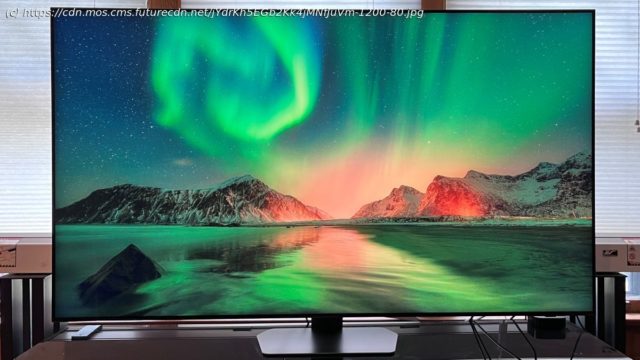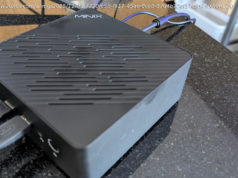Samsung’s feature-packed Neo QLED has wide appeal
Samsung QN90C TV: Two-minute review
Samsung’s QN90C series TVs are the step-down offering in the company’s 2023 Neo QLED lineup. Neo QLED TVs feature a mini-LED backlight, which allows the set to deliver high brightness along with generally more refined local dimming than what you’ll get with a standard QLED model that uses a regular LED backlight.
For the QN90C, mini-LED backlighting lets it deliver peak light output approaching what Samsung’s flagship QN95C Neo QLED TVs are capable of, while also delivering the deep blacks that local dimming provides. And while the QN90C doesn’t quite hit the OLED-like heights of the QN95C when it comes to rendering the deepest shadows, its performance on that front is nonetheless impressive. Similar to other Samsung TVs, HDR support here extends to the HDR10+, HDR10, and HLG formats, but not Dolby Vision.
With its slim form factor, thin bezel and sturdy hexagonal plate stand, the QN90C has strong visual appeal and looks great when in Ambient Mode, which is a Samsung feature for displaying artwork and photos in a low-power mode. Its Tizen smart TV interface is somewhat more busy and complicated than what you’ll see on other 4K TVs, but it provides plenty of options to customize and extend its usability, particularly when it comes to smart home tech.
Gaming is a particularly strong point for Samsung Neo QLED TVs, and the QN90C offers up four 4K 120Hz-capable HDMI 2.1 ports for connecting next-gen game consoles. Its Gaming Hub greatly expands the possibilities for gamers with cloud-based services including Xbox, Nvidia GeForce Now, Amazon Luna, Utomik and more.
The QN90C has better than average audio performance for a TV, including an Object Tracking Sound Plus feature to enhance the directionality of effects in movie soundtracks. It also supports the company’s Q-Symphony feature, which lets you pair the TV with select Samsung soundbars for a more spacious and dynamic audio experience.
Samsung Neo QLED TVs tend to be pricey, and the QN90C is no exception. But you’ll be able to score one for a good deal less than the company’s flagship QN95C, and unless you’re an ardent videophile, the differences between the two won’t appear all that dramatic. There are definitely budget mini-LED alternatives from brands like TCL and Hisense that can be had for a lot less, but when it comes to features and design sophistication, they won’t be able to match the QN90C .Samsung QN90C TV review: price and release date
Release date: February 21, 2023
QN43QN90: $1,119 / £1,399 / AU$1,999
QN50QN90: $1,319 / £1,499 / AU$2,499
QN55QN90: $1,519 / £1,899 / AU$2,999
QN65QN90: $2,299 / £2,699 / AU$3,999
QN75QN90: $2,599 / £3,799 / AU$5,299
QN85QN90: $3,999 / £5,199 / AU$6,799
The QN90C series sits between Samsung’s flagship QN95C and QN85C series, both of which are also mini-LED backlit QLED TVs. A main difference between the QN90C and the step-down QN85C appears to be less advanced built-in audio features in the latter, while the QN95C series has an ultra-slim, zero bezel ‘Infinity One’ design.
Make no mistake – these are all high-end LCD TVs, with elevated pricing to prove it. With screens ranging from 43 inches to 85 inches, there are plenty of QN90C size options to choose from based on space or budget, with the 65-inch model I tested priced just a few hundred below an LG C3 OLED TV in the same screen size.Samsung QN90C TV review: SpecsSamsung QN90C TV review: features
Mini-LED backlight with local dimming
Native 4K with HDR10+ dynamic range
Gaming Hub for cloud gaming
Samsung’s QN90C series TVs use a QLED display panel and mini-LED backlight with full-array local dimming. A Neural Quantum Processor upscales regular HD images to 4K and a Neo Quantum HDR+ feature dynamically processes high dynamic range content. As with other Samsung TVs, HDR handling is limited to the HDR10+ format, with no Dolby Vision support. The QN90C also features an anti-glare screen coating, along with the company’s Ultra Viewing Angle tech to improve picture quality at far off-center seats.
Samsung’s own Tizen smart TV interface is used for streaming as well as home control via the Samsung SmartThings app. The company’s Bixby tech is also onboard for voice commands, and both Alexa and Google Assistant devices are supported. An ambient mode can be activated that shows a wide range of still and animated images when the TV is not in use, and you can both customize these and upload your own images for display.
The QN90C series sports Samsung’s NeoSlim Design, one that still allows room for a built-in 4.2.2-channel Dolby Atmos speaker system. Samsung’s Object Tracking Sound Plus processing helps to make sounds coming from the screen more natural and believable, and there’s also a Q-Symphony 3.0 feature that combines the TV’s audio output with a Samsung soundbar for an enhanced presentation.
Samsung’s Gaming Hub provides a central destination for gaming apps and settings, with cloud gaming services such as Xbox, Nvidia GeForce Now, Amazon Luna, Utomik, and more supported. You can set up a Bluetooth controller to use for cloud gaming and games with HDR10+ high dynamic range are supported.
All four of the TV’s HDMI 2.1 inputs support 4K 120Hz input from a PS5 or Xbox Series X game console. The set also has an RF antenna input, and when a digital TV antenna is connected, its built-in ATSC 3.0 tuner will tune NextGen digital stations in the US.
Features Score: 5/5 Samsung QN90C TV review: picture quality
High peak brightness
Deep blacks with detailed shadows
Some backlight blooming
The 65-inch Samsung QN90C TV I tested delivered impressive peak HDR brightness, with the set measuring 1,787 nits (measured on a 10% white window test pattern) in its Movie picture mode. There is also a Filmmaker mode option, but that had lower brightness and was generally less accurate than Movie. In the TV’s Standard mode, peak brightness measured 1,219 nits. To give those numbers some context, Samsung’s flagship QN95C 4K mini-LED TV delivered 2,000 nits peak brightness in Movie mode when we tested it, and 2,240 nits in Standard mode.
The Samsung’s full-array local dimming backlight allows it to display 0 IRE full black, resulting in “infinite” contrast. It also did a very good job fleshing out shadow detail in dark scenes. Backlight “blooming” was evident, though, with light halos appearing around white-on-black movie titles and also pinpoints of light in the Starfield motion patterns from the Spears & Munsil Ultra HD HDR test Blu-ray. But these were minimal for the most part during regular viewing, though I did see some blooming in the transitions between bright sections of images and black letterbox bars on ultra-widescreen movies.
Home
United States
USA — software Samsung QN90C TV review: a bright mini-LED TV that looks good from...






